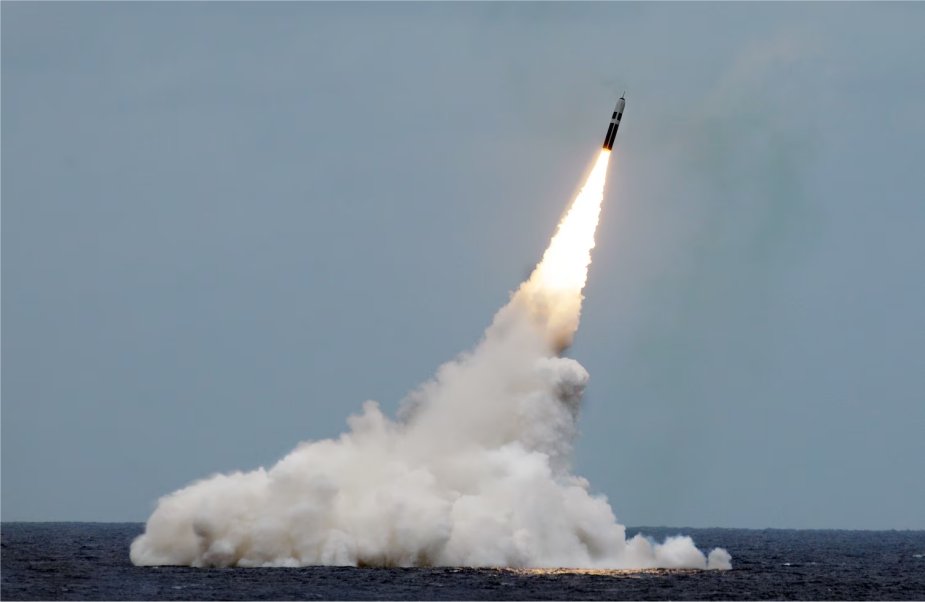Breaking news
Northrop Grumman hits production milestone with Trident II D5's 2000th rocket motor.
According to a PR published by Northrop Grumman Corporation on June 22, 2023, the company has achieved a significant milestone by producing its 2000th solid rocket motor for the U.S. Navy's Trident II D5 Submarine Launched Ballistic Missile (SLBM) program.
Follow Navy Recognition on Google News at this link
 An unarmed Trident II D5 missile is launched from the Ohio-class ballistic-missile submarine USS Maryland during a missile test. (Picture source: US DoD)
An unarmed Trident II D5 missile is launched from the Ohio-class ballistic-missile submarine USS Maryland during a missile test. (Picture source: US DoD)
This achievement marks the completion of the first-stage A1000 and second-stage B1000 motors. The company has produced over 800 first and second-stage tactical motors and more than 370 third-stage tactical motors since 1996, casting over 86 million pounds of propellant for D5 motors.
The prime contractor, Lockheed Martin, provides the Trident II D5 system to the U.S. Navy. The system has proved reliable, with 190 successful flight tests since deployment and no motor failures. The Trident II D5 missile is expected to continue serving as a key component of the U.S. Nuclear Triad for the foreseeable future.
The Trident II D5 SLBM, with a range of 4,000 nautical miles, is a three-stage, solid-fuel, inertially guided missile. Northrop Grumman manufactures the solid-propulsion boost motor systems for all three stages under a contract with Lockheed Martin.
Northrop Grumman has worked in partnership with Lockheed Martin and the U.S. Navy for almost 70 years to provide solid rocket motors for the SLBM system. The manufacture of the A1000 and B1000 motors attests to the enduring significance of the Trident II D5 program and the company's role as a crucial national security asset.
The firm and its predecessors have supported the Navy's deterrence mission for over 60 years, providing propulsion for submarine-launched systems starting with Polaris, Poseidon C3, Trident I C4, and now Trident II D5, which is not even halfway through its expected lifespan.
About the missile
The missile has a mass of 130,000 lbs or 59,000 kg, making it a hefty piece of equipment. Its length is 44 ft 6.6 in (13.579 m), and the diameter of the first stage is 6 ft 11 in (2.11 m).
As for the warhead, the Trident 5 offers flexibility and power. It can carry 1-12 Mk-5 re-entry vehicles (RVs) with W88 warheads each delivering 475 kilotons (kt) of explosive force, or 1-14 Mk-4 RVs with W76-0 warheads (100 kt), or 1-14 Mk-4A RVs with W-76-1 warheads (90 kt). It also has the capability to carry single or multiple W76-2 warheads, each delivering a force of 5-7 kt.
The Trident 5 utilizes three solid-fuel rocket motors for propulsion. The first and second stages use Thiokol/Hercules solid-fueled rockets, while the third stage employs a United Technologies Corp. solid-fueled rocket. The propellant it uses is NEPE-75, which consists of nitrate ester, plasticized polyethylene glycol-bound HMX, Aluminum, and ammonium perchlorate.
It can travel more than 7,500 miles (12,000 km), although the exact range is classified. It also boasts an impressive maximum speed of approximately 18,030 mph (29,020 km/h), equivalent to Mach 24 or 8,060 m/s in the terminal phase.
The missile uses a MK 6 astro-inertial guidance system that can receive updates from the Global Positioning System. It is steered by a single movable nozzle that is actuated by a gas generator.



























